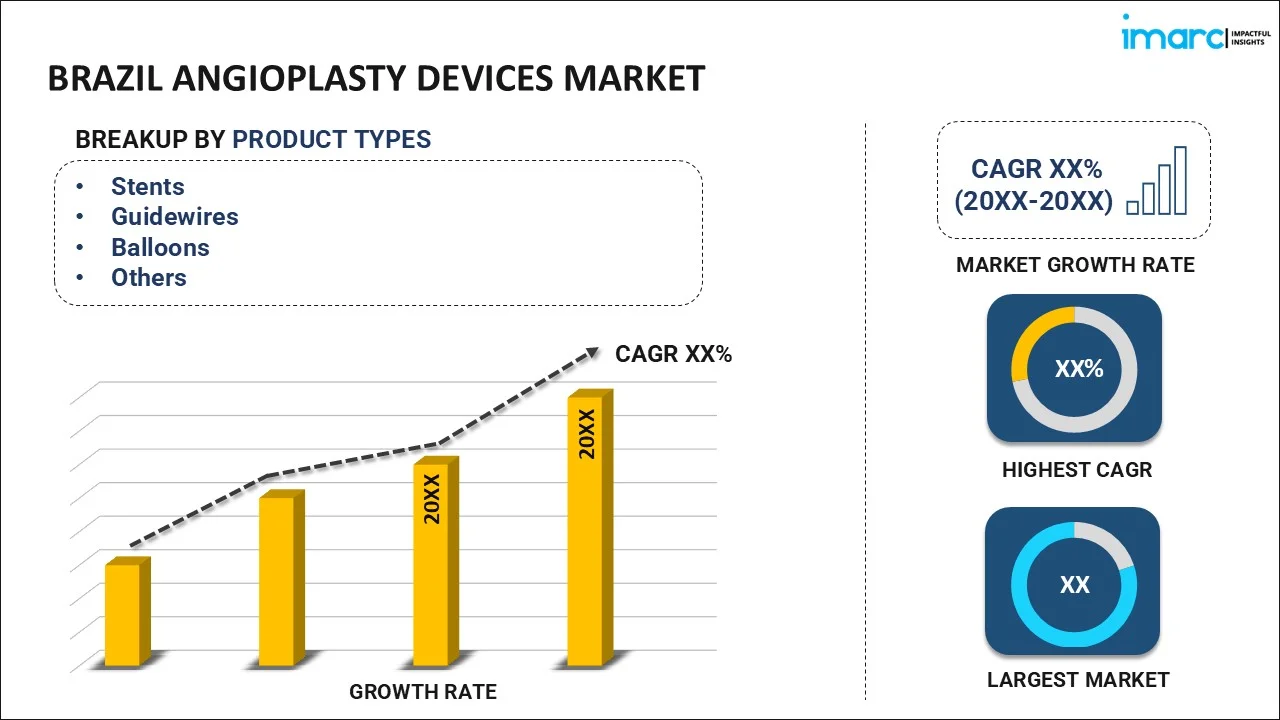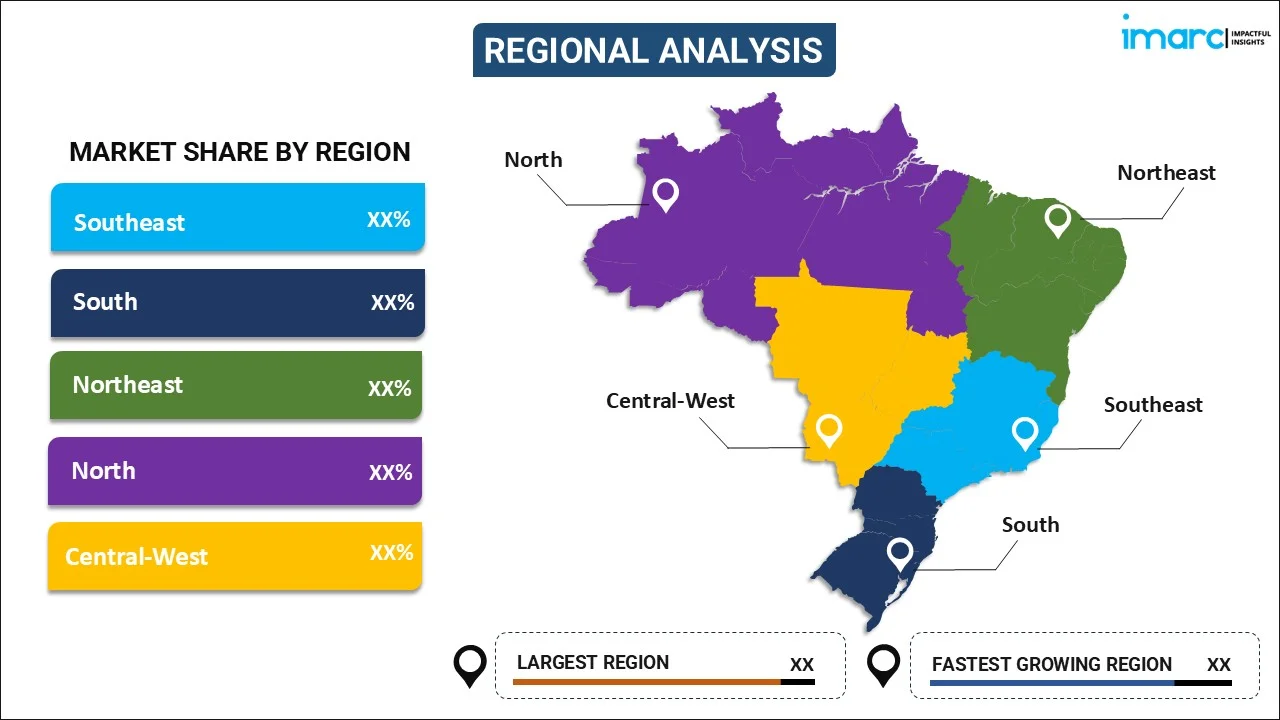
Brazil Angioplasty Devices Market Report by Product Type (Stents, Guidewires, Balloons, and Others), Application (Coronary Angioplasty, Peripheral Angioplasty), End User (Hospitals, Specialty Clinics, and Others), and Region 2025-2033
Brazil Angioplasty Devices Market Overview:
The Brazil angioplasty devices market size reached USD 266.0 Million in 2024. Looking forward, IMARC Group expects the market to reach USD 419.2 Million by 2033, exhibiting a growth rate (CAGR) of 5.18% during 2025-2033. The market is experiencing significant growth due to growing geriatric population, rising cardiovascular disease prevalence and the widespread adoption of minimally invasive procedures. Technological advancements such as drug-eluting stents and bioresorbable scaffolds are driving market expansion further by improving patient outcomes and meeting the demand for advanced cardiovascular treatments.
|
Report Attribute
|
Key Statistics
|
|---|---|
|
Base Year
|
2024
|
|
Forecast Years
|
2025-2033
|
|
Historical Years
|
2019-2024
|
| Market Size in 2024 | USD 266.0 Million |
| Market Forecast in 2033 | USD 419.2 Million |
| Market Growth Rate 2025-2033 | 5.18% |
Brazil Angioplasty Devices Market Trends:
Rising Prevalence of Cardiovascular Disease
The rising prevalence of cardiovascular diseases (CVDs) in Brazil is a significant driver for the angioplasty devices market growth. The increasing incidence of conditions such as coronary artery disease, heart attacks and strokes is primarily attributed to lifestyle factors like poor dietary habits, insufficient physical activity, smoking and high stress levels which are increasingly common across the Brazilian population. These lifestyle choices contribute to the buildup of plaque in the arteries leading to a higher need for interventional cardiology procedures like angioplasty. As a result, the demand for angioplasty devices including stents and balloon catheters is expanding rapidly. This surge is further fueled by an aging population as older adults are more susceptible to CVDs necessitating more frequent cardiovascular interventions. In September 2023, Mount Sinai announced a partnership with the Brazilian Clinical Research Institute to advance global cardiovascular disease research and medical education. This collaboration aims to enhance the understanding, prevention, and treatment of cardiovascular diseases. By launching international research programs, clinical trials, and educational opportunities for medical professionals in Latin America, this initiative seeks to reduce health disparities and improve clinical practice through innovative techniques. Such efforts are likely to complement the rising demand for advanced interventional procedures and devices, further supporting the expansion of the angioplasty devices market in Brazil.
Growing Geriatric Population
Brazil’s aging population is a significant factor driving the demand for angioplasty devices. As people age, their risk of developing cardiovascular diseases (CVDs) such as coronary artery disease, heart attacks, and atherosclerosis increases. This is due to age-related changes in the cardiovascular system, including the stiffening of blood vessels and the accumulation of plaque in arteries. With Brazil's population over 60 years old rapidly expanding, there is a rising need for medical interventions like angioplasty to treat these conditions effectively. Angioplasty procedures, which open blocked or narrowed arteries, are crucial for improving blood flow and reducing the risk of severe cardiovascular events in older adults. Consequently, the growing elderly population in Brazil is driving the demand for angioplasty devices, contributing to the market growth. According to report published by PAN America Health Organization, Brazil’s health system faces the challenge of an aging population, with over 30 million people aged 60 and older, comprising 13% of the population. By 2030, this age group is expected to grow to around 50 million, representing 24% of the total population. This demographic shift poses a significant demand on the public health system, requiring adaptation and policy development to meet the healthcare needs of older citizens.
Brazil Angioplasty Devices Market News:
- In September 2023, Reewarm™ PTX Drug-Coated Balloon (DCB) Catheter by Endovastec™ was successfully used for the first time in Brazil at Paulo Sacramento Hospital in Sao Paulo. The catheter was utilized in a minimally invasive surgery to treat a patient with popliteal artery stenosis. Post-operative results indicated a successful operation as the patient's blood circulation improved. Endovastec™, a global medical device company, aims to expand its innovative products internationally for the benefit of patients with peripheral vascular diseases.
- In August 2023, Zylox-Tonbridge's ZENFlow Tiger LD PTA Dilatation Catheter received marketing approval from ANVISA, the Brazilian Health Regulatory Agency, for treating Budd-Chiari syndrome and iliac vein compression syndrome with percutaneous transluminal angioplasty (PTA). The catheter's unique features, such as a tapered tip and short shoulder, enable easier access through complex lesions. The company plans to launch the product in the South American market and anticipates improved treatment efficacy when used alongside mechanical thrombectomy devices and peripheral stents.
Brazil Angioplasty Devices Market Segmentation:
IMARC Group provides an analysis of the key trends in each segment of the market, along with forecasts at the country level for 2025-2033. Our report has categorized the market based on product type, application, and end user.
Product Type Insights:

- Stents
- Guidewires
- Balloons
- Others
The report has provided a detailed breakup and analysis of the market based on the product type. This includes stents, guidewires, balloons, and others.
Application Insights:
- Coronary Angioplasty
- Peripheral Angioplasty
A detailed breakup and analysis of the market based on the application have also been provided in the report. This includes coronary angioplasty and peripheral angioplasty.
End User Insights:
- Hospitals
- Specialty Clinics
- Others
The report has provided a detailed breakup and analysis of the market based on the end user. This includes hospitals, speciality clinics, and others.
Regional Insights:

- Southeast
- South
- Northeast
- North
- Central-West
The report has also provided a comprehensive analysis of all the major regional markets, which include Southeast, South, Northeast, North, and Central-West.
Competitive Landscape:
The market research report has also provided a comprehensive analysis of the competitive landscape. Competitive analysis such as market structure, key player positioning, top winning strategies, competitive dashboard, and company evaluation quadrant has been covered in the report. Also, detailed profiles of all major companies have been provided.
Brazil Angioplasty Devices Market Report Coverage:
| Report Features | Details |
|---|---|
| Base Year of the Analysis | 2024 |
| Historical Period | 2019-2024 |
| Forecast Period | 2025-2033 |
| Units | Million USD |
| Scope of the Report | Exploration of Historical Trends and Market Outlook, Industry Catalysts and Challenges, Segment-Wise Historical and Future Market Assessment:
|
| Product Types Covered | Stents, Guidewires, Balloons, Others |
| Applications Covered | Coronary Angioplasty, Peripheral Angioplasty |
| End Users Covered | Hospitals, Specialty Clinics, Others |
| Regions Covered | Southeast, South, Northeast, North, and Central-West |
| Customization Scope | 10% Free Customization |
| Post-Sale Analyst Support | 10-12 Weeks |
| Delivery Format | PDF and Excel through Email (We can also provide the editable version of the report in PPT/Word format on special request) |
Key Questions Answered in This Report:
- How has the Brazil angioplasty devices market performed so far and how will it perform in the coming years?
- What has been the impact of COVID-19 on the Brazil angioplasty devices market?
- What is the breakup of the Brazil angioplasty devices market on the basis of product type?
- What is the breakup of the Brazil angioplasty devices market on the basis of application?
- What is the breakup of the Brazil angioplasty devices market on the basis of end user?
- What are the various Brazil stages in the value chain of the Brazil angioplasty devices market?
- What are the key driving factors and challenges in the Brazil angioplasty devices?
- What is the structure of the Brazil angioplasty devices market and who are the key players?
- What is the degree of competition in the Brazil angioplasty devices market?
Key Benefits for Stakeholders:
- IMARC’s industry report offers a comprehensive quantitative analysis of various Brazil market segments, historical and current market trends, market forecasts, and dynamics of the Brazil angioplasty devices market from 2019-2033
- The research report provides the latest information on the market drivers, challenges, and opportunities in the Brazil angioplasty devices market.
- Porter's five forces analysis assist stakeholders in assessing the impact of new entrants, competitive rivalry, supplier power, buyer power, and the threat of substitution. It helps stakeholders to analyze the level of competition within the Brazil angioplasty devices industry and its attractiveness.
- Competitive landscape allows stakeholders to understand their competitive environment and provides an insight into the current positions of key players in the market.
Need more help?
- Speak to our experienced analysts for insights on the current market scenarios.
- Include additional segments and countries to customize the report as per your requirement.
- Gain an unparalleled competitive advantage in your domain by understanding how to utilize the report and positively impacting your operations and revenue.
- For further assistance, please connect with our analysts.
 Inquire Before Buying
Inquire Before Buying
 Speak to an Analyst
Speak to an Analyst
 Request Brochure
Request Brochure
 Request Customization
Request Customization




.webp)




.webp)












